Abstract
An in vivo murine model for immunodeficiency of both B and T cells is produced by continuous intraperitoneal infusion of 2'-deoxycoformycin (DCF), a specific tightly binding inhibitor of adenosine deaminase (ADase; adenosine aminohydrolase, EC 3.5.4.4). After DCF infusion, ADase of thymus, spleen, and lymph nodes was inhibited to varying degrees ranging from 57% to 100%. Immunodeficiency under these conditions was indicated by: (i) a striking decrease in lymphocyte response to the T-cell mitogens concanavalin A and phytohemagglutinin; (ii) an impairment of delayed hypersensitivity measured by the footpad reaction; (iii) a decrease in antibody production measured in both in vivo and in vitro plaque-forming cell assay; (iv) a significant prolongation of mouse skin allograft survival after transplantation into the C57BL/6J (H-2b) strain of skin from BALB/c (H-2d) mice; and (v) a marked lymphopenia. Histological examination indicated lymphoid degeneration in the thymus, lymph nodes, and spleen with no alterations in other tissues including bone marrow, kidney, lung, gastrointestinal tract, and liver except for the occurrence of hepatitis. A decrease in the number of Thy-1-positive cells in both spleen and lymph nodes further supported the fact of cytotoxicity of DCF to T cells. Anorexia and weight loss were observed within 5 days of continuous DCF infusion at 0.4 mg/kg body weight per day. These data indicate that this method provides an experimental model for future studies on the biochemical mechanisms responsible for the genetically determined severe combined immunodeficiency disease in man.
Full text
PDF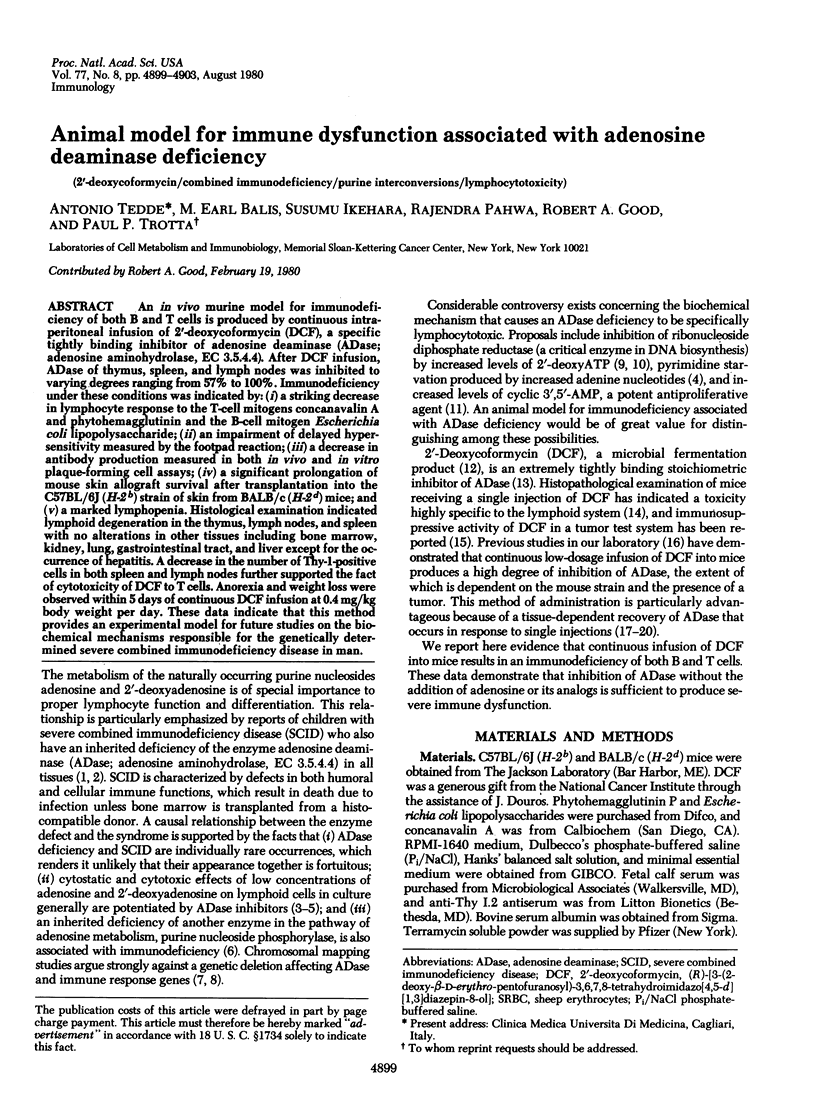
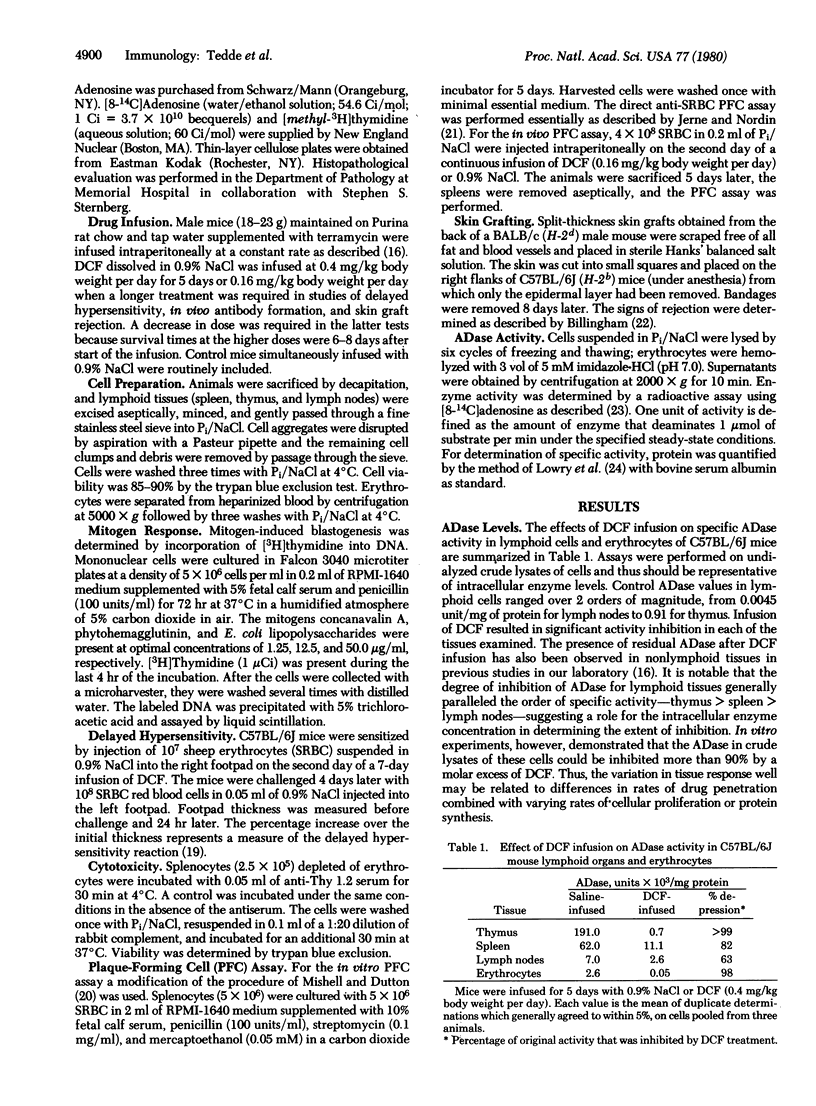
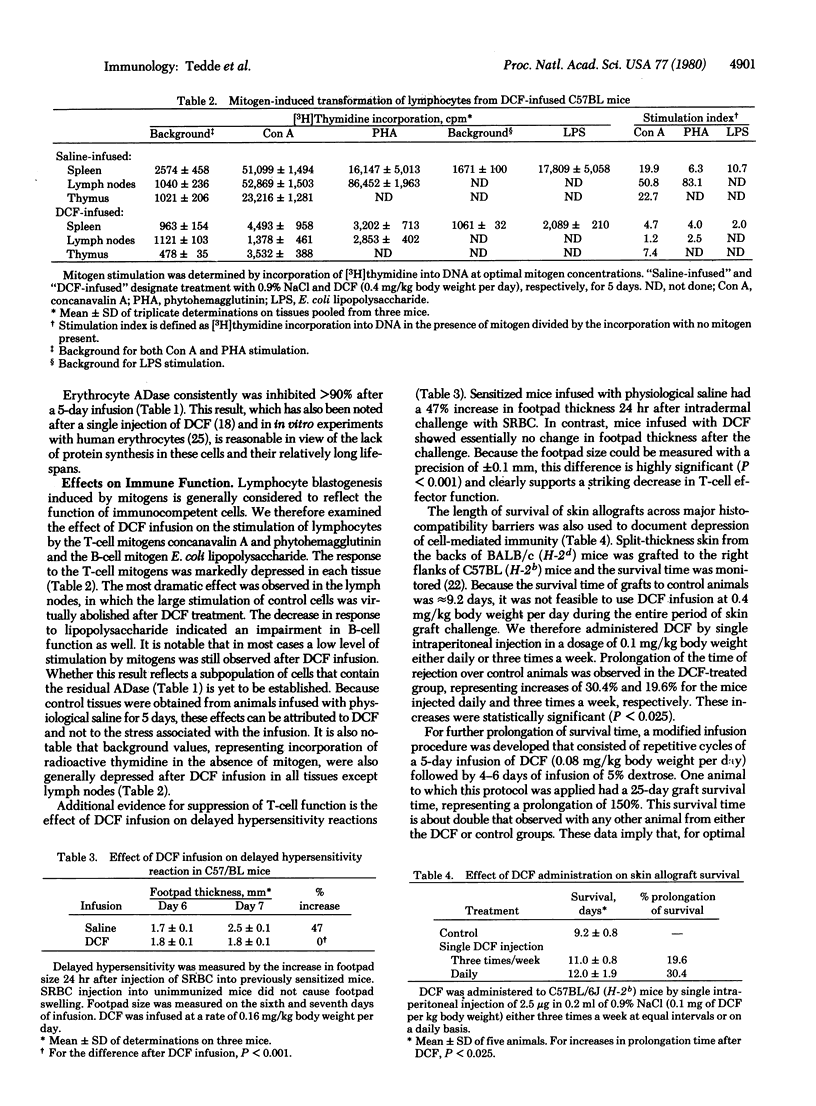
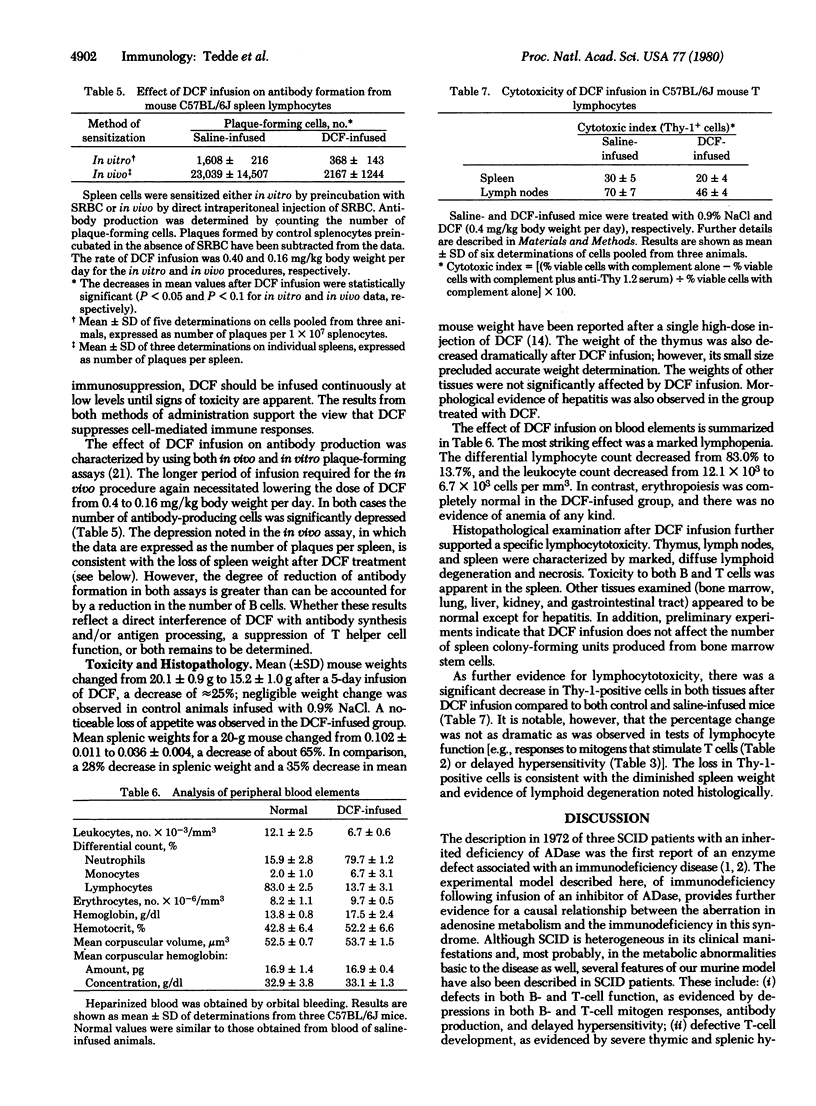
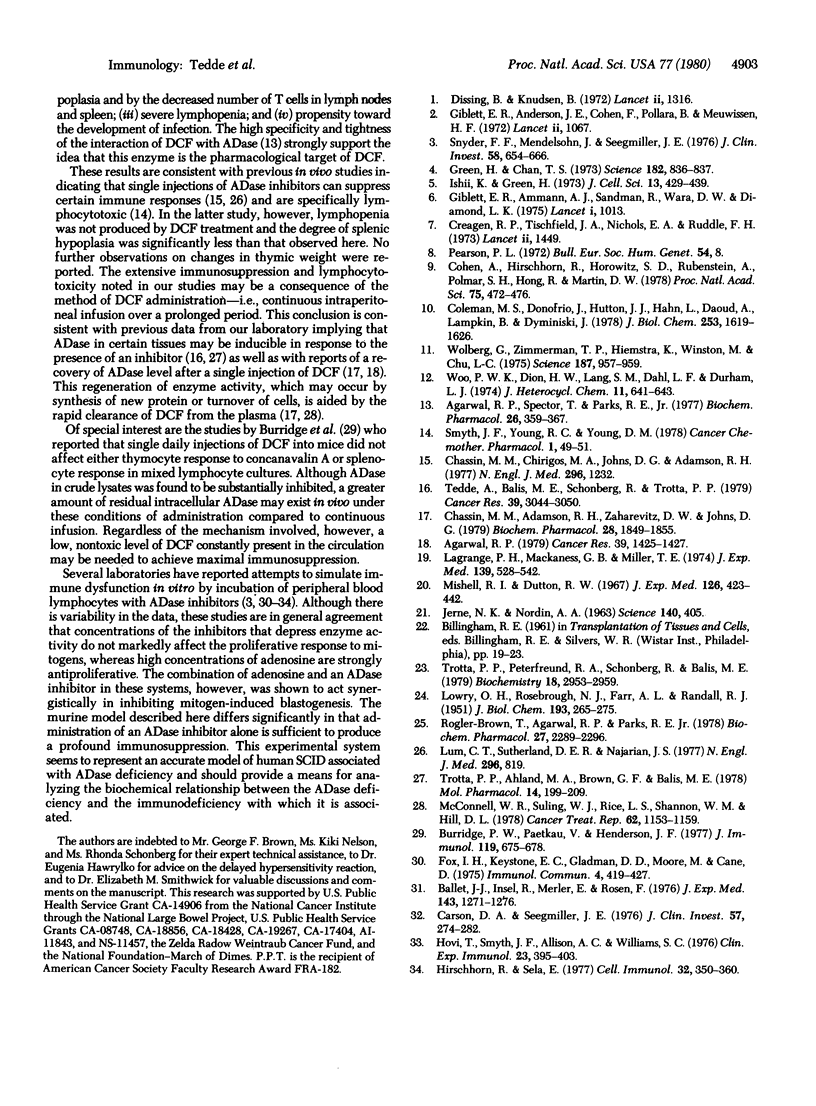
Selected References
These references are in PubMed. This may not be the complete list of references from this article.
- Agarwal R. P. Recovery of 2'-deoxycoformycin-inhibited adenosine deaminase of mouse erythrocytes and leukemia L1210 in vivo. Cancer Res. 1979 Apr;39(4):1425–1427. [PubMed] [Google Scholar]
- Agarwal R. P., Spector T., Parks R. E., Jr Tight-binding inhibitors--IV. Inhibition of adenosine deaminases by various inhibitors. Biochem Pharmacol. 1977 Mar 1;26(5):359–367. doi: 10.1016/0006-2952(77)90192-7. [DOI] [PubMed] [Google Scholar]
- Ballet J. J., Insel R., Merler E., Rosen F. S. Inhibition of maturation of human precursor lymphocytes by coformycin, an inhibitor of the enzyme adenosine deaminase. J Exp Med. 1976 May 1;143(5):1271–1276. doi: 10.1084/jem.143.5.1271. [DOI] [PMC free article] [PubMed] [Google Scholar]
- Burridge P. W., Paetkau V., Henderson J. F. Studies of the relationship between adenosine deaminase and immune function. J Immunol. 1977 Aug;119(2):675–678. [PubMed] [Google Scholar]
- Carson D. A., Seegmiller J. E. Effect of adenosine deaminase inhibition upon human lymphocyte blastogenesis. J Clin Invest. 1976 Feb;57(2):274–282. doi: 10.1172/JCI108278. [DOI] [PMC free article] [PubMed] [Google Scholar]
- Chassin M. M., Adamson R. H., Zaharevitz D. W., Johns D. G. Enzyme inhibition titration assay for 2'-deoxycoformycin and its application to the study of the relationship between drug concentration and tissue adenosine deaminase in dogs and rats. Biochem Pharmacol. 1979 Jun 15;28(12):1849–1855. doi: 10.1016/0006-2952(79)90636-1. [DOI] [PubMed] [Google Scholar]
- Chassin M. M., Chirigos M. A., Johns D. G., Adamson R. H. Adenosine deaminase inhibition for immunosuppression. N Engl J Med. 1977 May 26;296(21):1232–1232. [PubMed] [Google Scholar]
- Cohen A., Hirschhorn R., Horowitz S. D., Rubinstein A., Polmar S. H., Hong R., Martin D. W., Jr Deoxyadenosine triphosphate as a potentially toxic metabolite in adenosine deaminase deficiency. Proc Natl Acad Sci U S A. 1978 Jan;75(1):472–476. doi: 10.1073/pnas.75.1.472. [DOI] [PMC free article] [PubMed] [Google Scholar]
- Coleman M. S., Donofrio J., Hutton J. J., Hahn L., Daoud A., Lampkin B., Dyminski J. Identification and quantitation of adenine deoxynucleotides in erythrocytes of a patient with adenosine deaminase deficiency and severe combined immunodeficiency. J Biol Chem. 1978 Mar 10;253(5):1619–1626. [PubMed] [Google Scholar]
- Creagan R. P., Tischfield J. A., Nichols E. A., Ruddle F. H. Letter: Autosomal assignment of the gene for the form of adenosine deaminase which is deficient in patients with combined immunodeficiency syndrome. Lancet. 1973 Dec 22;2(7843):1449–1449. doi: 10.1016/s0140-6736(73)92850-x. [DOI] [PubMed] [Google Scholar]
- Dissing J., Knudsen B. Adenosine-deaminase deficiency and combined immunodeficiency syndrome. Lancet. 1972 Dec 16;2(7790):1316–1316. doi: 10.1016/s0140-6736(72)92692-x. [DOI] [PubMed] [Google Scholar]
- Fox I. H., Keystone E. C., Gladman D. D., Moore M., Cane D. Inhibition of mitogen mediated lymphocyte blastogenesis by adenosine. Immunol Commun. 1975;4(5):419–427. doi: 10.3109/08820137509057330. [DOI] [PubMed] [Google Scholar]
- Giblett E. R., Ammann A. J., Wara D. W., Sandman R., Diamond L. K. Nucleoside-phosphorylase deficiency in a child with severely defective T-cell immunity and normal B-cell immunity. Lancet. 1975 May 3;1(7914):1010–1013. doi: 10.1016/s0140-6736(75)91950-9. [DOI] [PubMed] [Google Scholar]
- Giblett E. R., Anderson J. E., Cohen F., Pollara B., Meuwissen H. J. Adenosine-deaminase deficiency in two patients with severely impaired cellular immunity. Lancet. 1972 Nov 18;2(7786):1067–1069. doi: 10.1016/s0140-6736(72)92345-8. [DOI] [PubMed] [Google Scholar]
- Green H., Chan T. Pyrimidine starvation induced by adenosine in fibroblasts and lymphoid cells: role of adenosine deaminase. Science. 1973 Nov 23;182(4114):836–837. doi: 10.1126/science.182.4114.836. [DOI] [PubMed] [Google Scholar]
- Hirschhorn R., Sela E. Adenosine deaminase and immunodeficiency: an in vitro model. Cell Immunol. 1977 Aug;32(2):350–360. doi: 10.1016/0008-8749(77)90211-8. [DOI] [PubMed] [Google Scholar]
- Hovi T., Smyth J. F., Allison A. C., Williams S. C. Role of adenosine deaminase in lymphocyte proliferation. Clin Exp Immunol. 1976 Mar;23(3):395–403. [PMC free article] [PubMed] [Google Scholar]
- Ishii K., Green H. Lethality of adenosine for cultured mammalian cells by interference with pyrimidine biosynthesis. J Cell Sci. 1973 Sep;13(2):429–439. doi: 10.1242/jcs.13.2.429. [DOI] [PubMed] [Google Scholar]
- Jerne N. K., Nordin A. A. Plaque Formation in Agar by Single Antibody-Producing Cells. Science. 1963 Apr 26;140(3565):405–405. doi: 10.1126/science.140.3565.405. [DOI] [PubMed] [Google Scholar]
- LOWRY O. H., ROSEBROUGH N. J., FARR A. L., RANDALL R. J. Protein measurement with the Folin phenol reagent. J Biol Chem. 1951 Nov;193(1):265–275. [PubMed] [Google Scholar]
- Lagrange P. H., Mackaness G. B., Miller T. E. Influence of dose and route of antigen injection on the immunological induction of T cells. J Exp Med. 1974 Mar 1;139(3):528–542. doi: 10.1084/jem.139.3.528. [DOI] [PMC free article] [PubMed] [Google Scholar]
- Lum C. T., Sutherland D. E., Najarian J. S. Inhibition for immunosuppression. N Engl J Med. 1977 Apr 7;296(14):819–819. doi: 10.1056/NEJM197704072961417. [DOI] [PubMed] [Google Scholar]
- McConnell W. R., Suling W. J., Rice L. S., Shannon M., Hill D. L. Use of microbiologic and enzymatic assays in studies on the disposition of 2'-deoxycomformycin in the mouse. Cancer Treat Rep. 1978 Aug;62(8):1153–1159. [PubMed] [Google Scholar]
- Mishell R. I., Dutton R. W. Immunization of dissociated spleen cell cultures from normal mice. J Exp Med. 1967 Sep 1;126(3):423–442. doi: 10.1084/jem.126.3.423. [DOI] [PMC free article] [PubMed] [Google Scholar]
- Rogler-Brown T., Agarwal R. P., Parks R. E., Jr Tight binding inhibitors--VI. Interactions of deoxycoformycin and adenosine deaminase in intact human erythrocytes and sarcoma 180 cells. Biochem Pharmacol. 1978;27(19):2289–2296. doi: 10.1016/0006-2952(78)90133-8. [DOI] [PubMed] [Google Scholar]
- Smyth J. F., Young R. C., Young D. M. In vivo toxicity to lymphoid tissue by 2'-deoxycoformycin. Cancer Chemother Pharmacol. 1978;1(1):49–51. doi: 10.1007/BF00253146. [DOI] [PubMed] [Google Scholar]
- Snyder F. F., Mendelsohn J., Seegmiller J. E. Adenosine metabolism in phytohemagglutinin-stimulated human lymphocytes. J Clin Invest. 1976 Sep;58(3):654–666. doi: 10.1172/JCI108512. [DOI] [PMC free article] [PubMed] [Google Scholar]
- Tedde A., Balis M. E., Schonberg R., Trotta P. P. Effects of 2'-deoxycoformycin infusion on mouse adenosine deaminase. Cancer Res. 1979 Aug;39(8):3044–3050. [PubMed] [Google Scholar]
- Trotta P. P., Ahland M. P., Brown G. F., Balis M. E. Studies on the effects of infusion of enzyme inhibitors on mouse adenosine deaminase. Mol Pharmacol. 1978 Jan;14(1):199–209. [PubMed] [Google Scholar]
- Trotta P. P., Peterfreund R. A., Schonberg R., Balis M. E. Rabbit adenosine deaminase conversion proteins. Purification and characterization. Biochemistry. 1979 Jul 10;18(14):2953–2959. doi: 10.1021/bi00581a006. [DOI] [PubMed] [Google Scholar]
- Wolberg G., Zimmerman T. P., Hiemstra K., Winston M., Chu L. C. Adenosine inhibition of lymphocyte-mediated cytolysis: possible role of cyclic adenosine monophosphate. Science. 1975 Mar 14;187(4180):957–959. doi: 10.1126/science.167434. [DOI] [PubMed] [Google Scholar]


